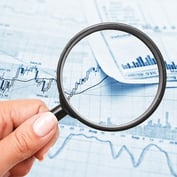In a previous article I wrote about the role that stock dividends can play in generating sustainable retirement income.
But there’s a catch, of course: dividends aren’t guaranteed and the reduction or elimination of a dividend can wreak havoc with the issuing stock’s price. That means dividend safety is a top concern for retirees.
I recently asked Tom Huber, manager of the T. Rowe Price Dividend Growth Fund (symbol PRDGX) in Baltimore, Maryland, for his thoughts on dividend safety.
According to its website, the fund, which held about $4.1 billion of assets as of April 30, “…will normally invest at least 65% of its total assets in stocks, with an emphasis on stocks that have a strong track record of paying dividends or that are expected to increase their dividends over time.”
Don’t get cut
From one perspective a dividend cut could be a positive sign that the company believes it can earn a higher return by retaining its funds. That’s not much solace for investors who bought it for its payout, though.
In reality, cuts or omissions are usually a bad sign the business is under pressure and that its ability to cover its dividend is no longer viable, says Huber. Stocks typically don’t do well in that situation.
Check the balance sheet
Checking a company’s dividend payout ratio—the dividend amount divided by the company’s earnings—can indicate if the business is likely to sustain its dividend.
That ratio varies across industries and among the companies in an industry. Huber cites food and beverage company PepsiCo (PEP) as an example.
The company’s dividend ratio is roughly 50 percent, which he says is an acceptable ratio for the company because it’s generally a stable business. Utility companies tend to have higher payout ratios but industrial businesses are usually lower, often in the 30 to 40 percent range.
A company’s leverage—the amount of debt it carries—is another valuable indicator.
If the company’s sales slows and its earnings come under pressure, a heavy debt load can limit the amount of free cash flow left over for dividends after making interest payments.
Go for growth
Inflation doesn’t stop at retirement; growing dividends can help retirees’ income keep pace. Huber points to two potential sources of that growth in the stocks he considers for his fund.
The first comes from companies that historically haven’t paid dividends but are initiating them. Investors can also benefit from holding stocks whose boards plan to increase their payout ratios over time.
Dividend stocks have had a good run over the past few years but Huber believes they can still deliver solid total returns. “The outlook for dividends and dividend investors is still pretty healthy,” he says.
“The payout ratio, if you look from a bigger picture perspective, just on the S&P 500, is still in the low 30 percent range. If you go back a long time over history, that payout ratio has averaged more close to 45 or 50 percent.
“So as investors continue to look for and seek yield in this low-rate environment, these dividend paying stocks still can look pretty attractive and those bigger statistics would suggest that there’s still room for nice growth as that payout ratio moves up over time.”
 Discover relevant content from across the suite of ALM legal publications
From the Industry
Discover relevant content from across the suite of ALM legal publications
From the Industry  More content from ThinkAdvisor and select sponsors
Investment Advisor Issue Gallery
More content from ThinkAdvisor and select sponsors
Investment Advisor Issue Gallery  Read digital editions of Investment Advisor Magazine
Tax Facts
Read digital editions of Investment Advisor Magazine
Tax Facts  Get clear, current, and reliable answers to pressing tax questions
Get clear, current, and reliable answers to pressing tax questions
 Copyright © 2024 ALM Global, LLC. All Rights Reserved.
Copyright © 2024 ALM Global, LLC. All Rights Reserved.
 Copyright © 2024 ALM Global, LLC. All Rights Reserved.
Copyright © 2024 ALM Global, LLC. All Rights Reserved.







 June 09, 2014 at 10:37 AM
June 09, 2014 at 10:37 AM










